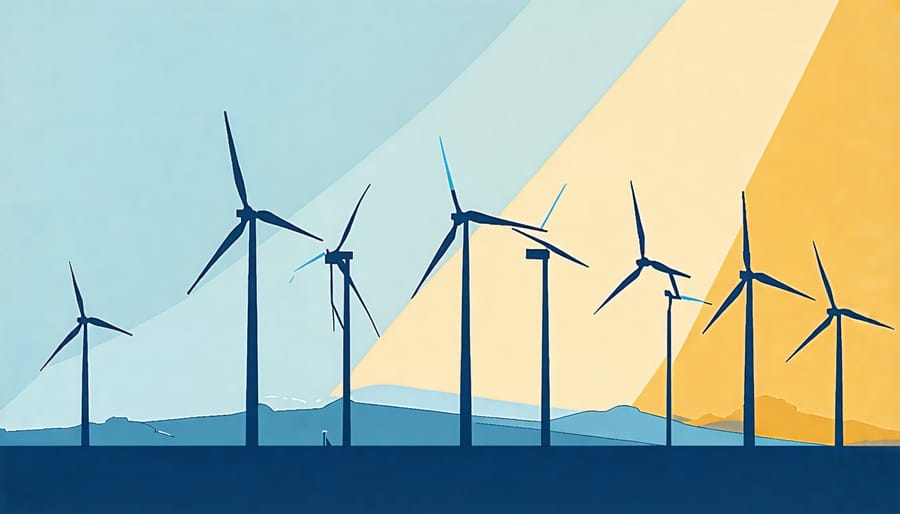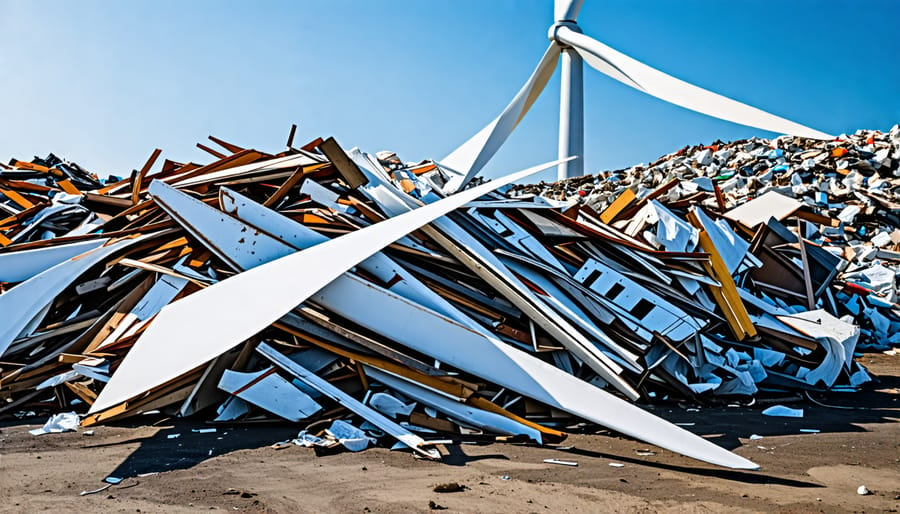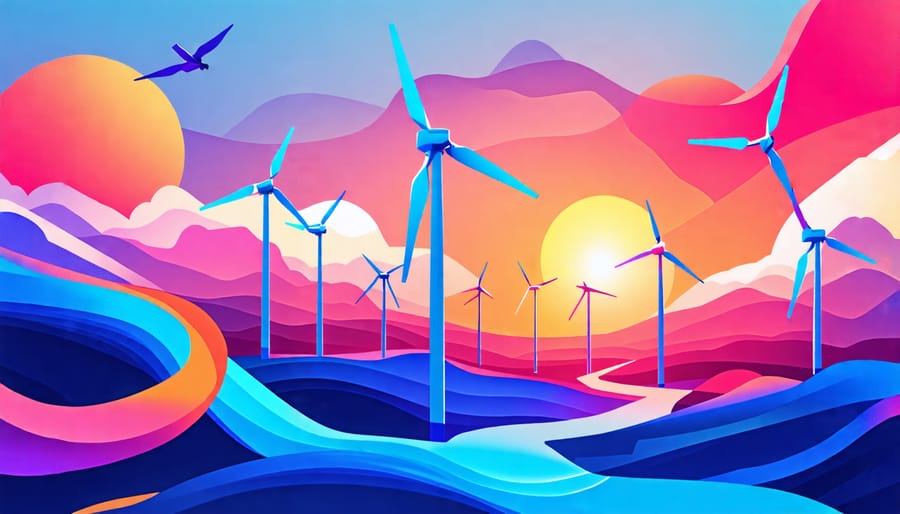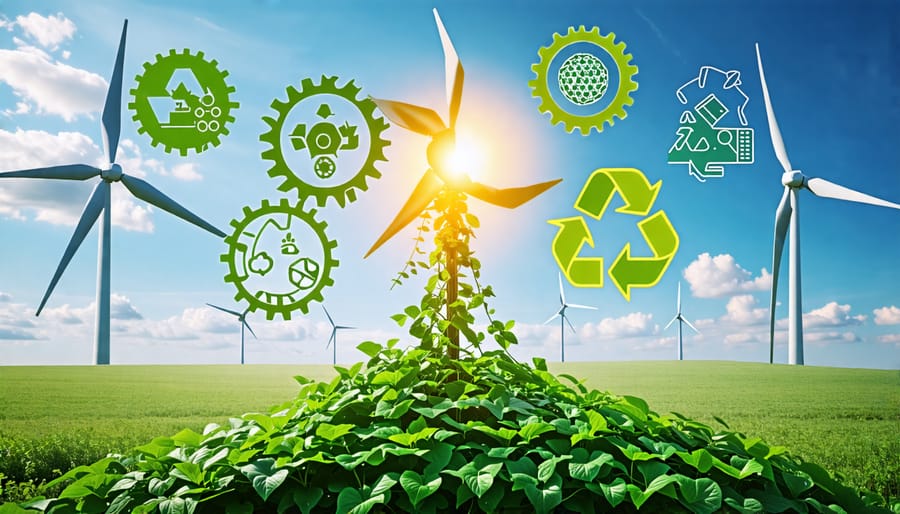Utilize innovative mechanical processes to dismantle wind turbine blades, transforming fiberglass into reusable raw materials. Employ chemical recycling techniques, such as solvolysis, to break down complex materials into valuable compounds. Collaborate with companies specializing in composite material recycling to repurpose turbine components into products like furniture or construction materials. Invest in cutting-edge research that explores biodegradable materials for future wind turbines, reducing long-term waste. Consider partnering with academic institutions for access to the latest advancements in sustainable material technology, ensuring a circular lifecycle for wind turbines. Embrace these methods to enhance the environmental impact of wind energy, creating a more sustainable future for all.
The Lifecycle of a Wind Turbine

From Installation to Decommissioning
From the moment a wind turbine is installed, it embarks on a carefully orchestrated journey through its lifecycle, one which promises sustainable energy but also unveils certain challenges. Starting with its robust energy output, wind turbines are pivotal in harnessing wind to generate clean electricity. Their towering structures and spinning blades are iconic symbols of renewable energy, promising decades of operation. However, as with all machinery, these turbines eventually reach the end of their functional lives.
The installation stage involves transporting and erecting massive components, which themselves are feats of engineering. These components include the tower, nacelle, and blades, often made from metals, composites, and other materials designed for longevity. Throughout their operational life, regular maintenance ensures optimum performance and extends their longevity. Routine checks and repairs are necessary to maximize their energy output and efficiency while minimizing downtime.
As turbines near the end of their productive span, usually around 20-25 years, decommissioning begins—a process entailing careful dismantling to ensure safety and environmental compliance. This stage introduces significant challenges, particularly in recycling complex materials like fiberglass blades. These blades pose a problem due to their size and composite material structure, which complicates traditional recycling methods.
Innovative solutions are emerging, such as repurposing blades in construction or cutting them into smaller pieces for processing. Companies and researchers are increasingly focused on developing greener materials in the manufacturing phase to simplify recycling later on. Real-life case studies exemplify the potential of these solutions, showcasing how collaboration across industries can pave the way to a sustainable wind energy future. This lifecycle story of wind turbines underscores the importance of addressing both energy demands and ecological impacts, ultimately contributing to a more sustainable planet.
Current Challenges in Wind Turbine Disposal
Environmental Impact
The increasing use of wind energy represents a promising leap towards sustainability, yet dismantling wind turbines presents distinct ecological challenges. One of the significant hurdles is the lifespan of turbine blades, often made from composite materials like fiberglass, which are notoriously difficult to recycle. Traditional landfilling methods are not sustainable and pose a threat to the environment due to their bulkiness and chemical composition. However, innovative recycling methods are emerging as viable solutions. For instance, some companies are pioneering processes to break down the blades into reusable materials, such as concrete and asphalt additives. This not only prevents waste but also reduces the carbon footprint associated with manufacturing these conventional materials. Furthermore, repurposing projects, like turning old turbine parts into playground equipment or bridges, showcase creative reuse options. As the wind energy industry continues to grow, fostering an infrastructure for more effective recycling solutions will be crucial to minimizing environmental impact and encouraging a circular economy.

Logistical and Economic Hurdles
Recycling wind turbines poses significant logistical and economic hurdles. With many turbines reaching their end-of-life phase, the challenge of dismantling and transporting these massive structures is pressing. These blades, often made from composite materials for durability, are not easily recyclable. Current processes are labor-intensive and costly, involving cutting blades into transportable segments. Additionally, the recycling facilities capable of handling these materials are limited, leading to increased transportation costs and emissions.
Economically, the absence of established markets for recycled turbine materials compounds the issue. The unpredictable costs and lack of incentives for recycling diminish potential financial returns. Despite these challenges, innovative solutions are emerging. Companies are exploring chemical recycling methods that could efficiently break down blade materials for reuse, potentially lowering costs and environmental impact. Furthermore, initiatives to develop a circular economy for turbine components could transform these hurdles into opportunities, paving the way for a more sustainable future in renewable energy.
Innovative Solutions for Recycling Wind Turbines
Advancements in Blade Recycling
As the demand for renewable energy sources like wind turbines continues to rise, so does the importance of sustainable solutions for end-of-life turbine components, particularly blades. Historically, the fiberglass and resins used in turbine blades made them challenging to recycle. However, recent innovations are paving the way for more effective recycling methods. One promising development is the advent of thermal recycling techniques, which involve processing the blades at high temperatures to separate and reclaim valuable materials like fiberglass and carbon fibers. This method not only reduces landfill waste but also provides materials that can be repurposed into new products.
Another breakthrough is the chemical recycling process, which involves breaking down the composite materials of the blades into their chemical components. This enables the extraction of high-quality raw materials that can be reincorporated into manufacturing processes, potentially leading to a closed-loop lifecycle for turbine blade materials. In addition, mechanical recycling—chipping the blades into small fragments for use in construction or as fillers in other industrial applications—has gained traction as a viable alternative.
Real-world examples of these advancements can be seen in partnerships between industry leaders and research institutions. For instance, collaborative efforts in Europe have successfully implemented pilot projects demonstrating the economic and environmental viability of blade recycling, setting a standard for future global practices. These methods not only highlight the potential for reducing the environmental footprint of wind energy but also offer a glimpse into a future where sustainability and innovation go hand in hand.

Circular Economy in Action
As the wind industry continues to grow, circular economy principles are pivotal in revolutionizing how turbine materials are utilized and reused. In the past, the disposal of wind turbine blades, which are typically made from composite materials, posed significant environmental challenges. However, innovative approaches are bringing a new lifecycle to these materials.
For instance, companies are developing methods to break down these composites into reusable raw materials, effectively closing the loop on what was once seen as waste. These processes not only extend the life of the materials but also reduce the need for virgin resources. A remarkable project in Europe uses recovered fiberglass from blades to reinforce concrete, demonstrating practical, environmentally-friendly solutions.
This shift towards a circular model is not confined to blades alone. Gearboxes and other metallic components from decommissioned turbines are being refurbished and re-entering the production cycle, cutting down emissions substantially. Experts in the field, such as Dr. James Porter from the Wind Energy Research Centre, argue that adopting such methods can make renewable energy sources more competitive, a comparison you can learn more about in our article on wind vs solar.
As we advance, the commitment to sustainable practices in the wind sector showcases the potential for a greener and more resource-efficient future. By embracing these strategies, the wind industry is steadily reinforcing its role as a leader in the transition to renewable energy, fostering an environment where the end-of-life stage of technology can serve as a starting point for the next innovation.
Real-life Success Stories
Case Study: Denmark’s Revolutionary Approach
Denmark has emerged as a frontrunner in the quest for sustainable wind turbine recycling. The country has embraced innovative strategies that are setting new benchmarks in the industry. One pioneering project involves reprocessing the composite materials of old turbine blades into products for the construction and automotive sectors. By establishing collaborations with research institutions and environmental organizations, Denmark is showcasing the potential of circular economy principles. This remarkable approach not only mitigates waste but also reduces the dependency on virgin resources.
Notably, Denmark’s efforts align with broader renewable innovations aimed at creating a more sustainable future. By investing in cutting-edge technologies, such as advanced separation processes and material treatment techniques, Danish companies are converting seemingly unusable waste into valuable materials.
Overall, Denmark’s revolutionary approach to wind turbine recycling offers a hopeful blueprint for other nations seeking to minimize environmental impact while advancing renewable energy solutions. Through visionary policy-making and sector-wide collaboration, Denmark is proving that sustainable progress is both achievable and rewarding.
Success in the USA: A Renewable Revolution
In the United States, a groundbreaking initiative in Iowa is making waves in the arena of wind turbine recycling. spearheaded by the collaborative efforts of engineering startups and local government agencies, this project focuses on the innovative repurposing of decommissioned turbine blades. As wind farms expand rapidly across the nation, their operators face the challenge of managing the end-of-life phase of turbine components. Often, these massive blades are landfilled, creating environmental and logistical issues. The Iowa initiative tackles this problem by transforming discarded blades into practical infrastructure components, such as pedestrian bridges and noise barriers along highways.
This creative approach sets an inspiring precedent for sustainable practices in the renewable energy sector. Moreover, it showcases the potential for economic growth through the creation of new jobs in the recycling and manufacturing sectors. Industry expert John Sullivan notes that such initiatives “not only reduce waste but also provide a blueprint for other states to adopt circular economy principles.” With its focus on sustainability and innovation, the project promises to invigorate the renewable energy landscape, encouraging further adoption of environmentally friendly practices across the U.S.
The Future of Wind Turbine Recycling
As the wind energy industry continues to grow, the future of wind turbine recycling holds promising potential for transforming sustainable energy practices. Innovative solutions are emerging to tackle the challenge of recycling these massive structures, particularly their blades, which are often made from composite materials. Researchers are developing processes to break down these composites into reusable materials, enabling the industry to create new blades from old ones, essentially closing the loop and minimizing waste.
Future trends point towards increased collaboration between wind energy companies and recycling technology developers. Partnerships with industries like construction and manufacturing could see recycled turbine materials repurposed into products such as bridges, playgrounds, or even furniture. These developments make economic sense and address environmental concerns about the growing volume of decommissioned turbines.
Policy changes also stand to significantly enhance recycling efforts. Legislation mandating the recycling of wind turbine components could accelerate technological advancements and ensure that all industry players commit to sustainable practices. Furthermore, financial incentives for companies investing in recycling infrastructure could stimulate the market and drive further innovation.
As sustainability takes center stage, the future of wind turbine recycling looks bright, presenting opportunities for environmental stewardship, economic growth, and technological advancement. This optimistic outlook is fueled by both industry pioneers and supportive policy frameworks aiming to shape a more sustainable world.
Conclusion
As we progress toward a sustainable future, the significance of recycling wind turbines becomes increasingly evident. Throughout this article, we’ve explored the lifecycle of wind turbines, their environmental impact, and the challenges and innovations shaping their recycling processes. Emphasizing these aspects underscores the vital role that advanced recycling techniques play in sustainable energy development. Real-life case studies and expert insights reveal that investing in efficient recycling methods not only mitigates waste but also fosters new opportunities within the renewable sector. Looking ahead, embracing such advancements paves the way for enhanced sustainability and the promising future prospects of wind energy.





